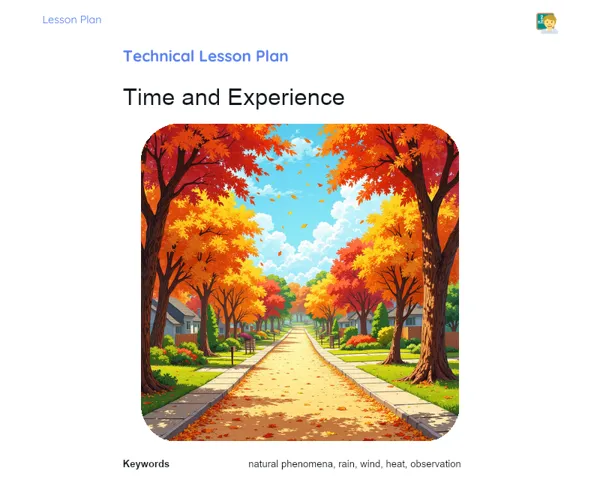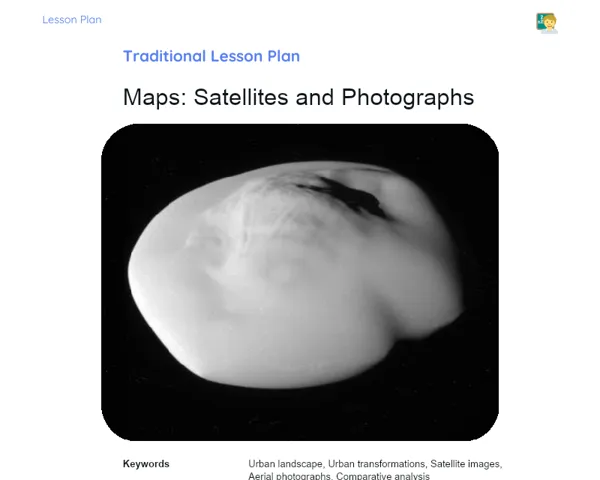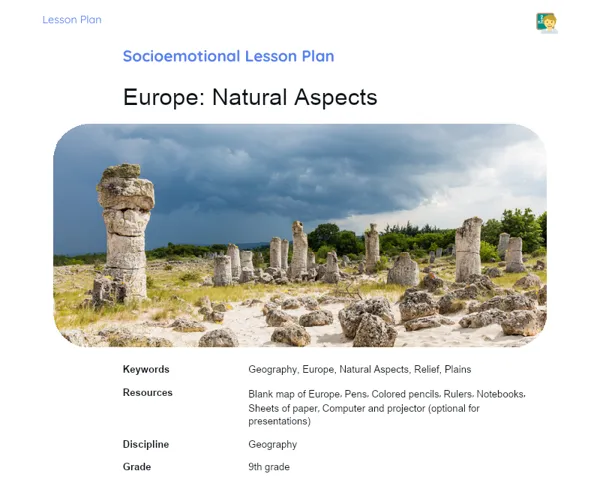Lesson Plan | Socioemotional Learning | Life and Natural Cycles
| Keywords | Natural Cycles, Geography, Natural Rhythms, Self-Knowledge, Self-Control, Decision-Making, Social Skills, Social Awareness, RULER, Guided Meditation, Outdoor Exploration, Emotional Reflection, Personal and Academic Goals |
| Resources | Clipboards, Paper, Colored Pencils, Cameras or Tablets (optional), Comfortable Chairs, Outdoor Space (garden or green area) |
| Codes | - |
| Grade | 1st grade |
| Discipline | Geography |
Objective
Duration: (10 - 15 minutes)
The aim of this stage is to introduce students to the concept of natural cycles, encouraging them to observe and describe these cycles in various contexts. This not only helps them recognize natural patterns but also understand how these patterns affect their lives differently. Additionally, it enhances their emotional intelligence by helping them perceive the emotions tied to their observations.
Objective Utama
1. Observe and describe natural rhythms at different spatial and temporal scales.
2. Compare students' realities with those around the world, identifying both similarities and differences.
Introduction
Duration: (15 - 20 minutes)
Emotional Warmup Activity
Journey to the Tranquil Garden
The selected emotional warm-up activity is 'Guided Meditation'. This practice assists students in focusing their minds, promoting a state of calm and concentration, guided by the teacher through a series of instructions to help them relax and envision peaceful scenarios, getting ready for the class ahead.
1. Invite students to sit comfortably in their seats, with straight backs and feet flat on the floor.
2. Ask them to close their eyes and place their hands on their knees, palms facing upwards.
3. Guide them to take a deep breath in through their nose, filling their lungs, then exhale slowly through their mouth, repeating this deep breathing three times.
4. Encourage students to visualize a tranquil garden teeming with colorful flowers and lush greenery. Ask them to imagine every detail including the scents, sounds, and colors.
5. Lead them through the imagined garden, describing a stone pathway that leads to a serene lake. Ask them to sit at the water's edge and observe the calmness.
6. Encourage them to focus on the feelings of peace and tranquility that this setting gives them and to hold onto that feeling for a few moments.
7. Gradually, direct students to start shifting their focus back to the classroom by gently moving their fingers and toes.
8. Instruct them to slowly open their eyes and stretch as they feel ready.
Content Contextualization
Natural cycles form an essential part of life on Earth. They encompass everything from the Earth's rotation causing day and night to the seasons, which directly affect climate and agriculture. Understanding these cycles gives us insight into how all elements of nature are interconnected and how our actions can impact the environment. Moreover, observing these cycles allows us to reflect on our own lives and emotions, realizing that all things have their own natural time and rhythm.
For instance, consider how the arrival of spring, with its blossoms and pleasant weather, can evoke feelings of joy and renewal, while winter may inspire us to feel more contemplative and calm. By understanding and respecting these cycles, we can manage our emotions better and appreciate the diversity and beauty that surrounds us.
Development
Duration: (60 - 75 minutes)
Theory Guide
Duration: (20 - 25 minutes)
1. Explain that natural cycles are repetitive patterns occurring in nature, such as day and night, the seasons, the water cycle, and the life cycle of plants and animals.
2. Define the cycle of day and night, explaining it is due to the Earth rotating on its axis once every 24 hours, resulting in daylight and darkness.
3. Describe the seasons, highlighting they are the result of the tilt of the Earth's axis as it orbits the Sun, leading to variations in temperature and daylight.
4. Introduce the water cycle, detailing how water circulates between the Earth’s surface and the atmosphere through evaporation, condensation, precipitation, and infiltration.
5. Elucidate the life cycle of plants and animals using simple examples like the change of a seed into a mature plant and the butterfly life cycle (egg, caterpillar, chrysalis, butterfly).
6. Use relatable analogies for better understanding, such as comparing the day and night cycle to a continuous dance between the Sun and the Earth, or likening the water cycle to an endless journey of water through the sky, rivers, oceans, and soil.
7. Give practical and relatable examples of natural cycles, like the blooming of specific flowers during certain times of the year or the migration patterns of certain birds.
Activity with Socioemotional Feedback
Duration: (35 - 45 minutes)
Exploring Natural Cycles in Our School Garden
Students will explore a garden or greenery within the school compound to observe and document various aspects of natural cycles. They will work in small groups to record their findings through drawings, descriptions, and photographs (if available).
1. Divide students into small groups of 3-4.
2. Provide clipboards, paper, and colored pencils for each group. If accessible, provide cameras or tablets for photography.
3. Instruct students to look for signs of the natural cycles discussed: evidence of day and night (such as shadows), seasonal changes (fallen leaves, blooming flowers), elements of the water cycle (puddles, streams), and the life cycles of plants and animals (flowers, insects).
4. Encourage students to draw or write about their observations, noting details about colors, shapes, and behaviors.
5. Move among the groups, helping students identify and name their observations correctly, linking them back to the theoretical concepts discussed.
6. After the exploration, gather students for each group to present their observations to the class.
Discussion and Group Feedback
Post-activity, utilize the RULER method to facilitate a group discussion. Recognize the emotions involved during exploration by asking students how they felt when they found evidence of natural cycles. Understand what caused those emotions by reflecting on how observing nature can evoke wonder and curiosity. Name those emotions to help students articulate their feelings, whether excitement, surprise, or calmness. Express these emotions appropriately, encouraging open discussion about their experiences. Regulate emotions by discussing methods to maintain positivity and manage any frustrations during the activity. Prompt students to reflect on how these emotions affect their learning and connection with the environment.
Conclusion
Duration: (20 - 25 minutes)
Reflection and Emotional Regulation
Following the exploration, encourage students to reflect on any challenges faced during the lesson. Prompt them to write or discuss how they felt while identifying and documenting natural cycles. Guide them to consider how they managed their emotions, particularly if they faced difficulties. Suggested prompt questions include: 'What was the biggest challenge for you?', 'How did you feel when you stumbled upon something new?' and 'How did you cope with those feelings?'. Foster an environment for sharing their experiences and listening to others.
Objective: This subsection aims to promote self-assessment and emotional regulation, helping students develop effective strategies to deal with challenging situations. Through reflecting on their emotions and how they navigated them, students gain increased emotional awareness and learn to apply these strategies in varied contexts, creating a more resilient learning environment.
Glimpse into the Future
To wrap up the lesson, encourage students to set personal and academic goals related to the themes discussed. Explain that these goals could involve observing natural cycles at home or on the way to school, or implementing what they've learned in other subjects. Motivate them to think about ways they can continue to explore natural cycles and how this learning can influence their daily lives.
Penetapan Objective:
1. Observe and record seasonal changes in their surroundings.
2. Identify and describe further natural cycles, such as the lunar cycle.
3. Share their findings about natural cycles with family and friends.
4. Create a nature observation journal to track their emotions and discoveries.
5. Participate in school or community initiatives that promote environmental awareness. Objective: This subsection aims to bolster students’ autonomy and practical application of their learning, encouraging them to enhance their skills of observation and reflection beyond the classroom. Setting personal and academic goals motivates students to apply their acquired knowledge persistently, fostering both academic and personal growth.



